Hummingbirds can easily capture anyone's interest due to their fascinating iridescent colors. What's better is that they're familiar backyard visitors!
The only issue is that hummingbirds are fast and small. The only reliable time to observe and identify them is while they eat.
So, when the opportunity arises, you must take it! We prepared a guide on identifying the eight species of hummingbirds in Illinois, along with some interesting facts. Read on!
8 Illinois Hummingbirds (With Pictures!)
1. Allen's Hummingbird (Selasphorus sasin)
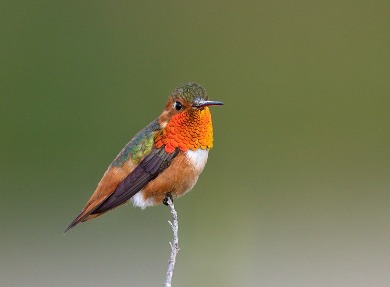
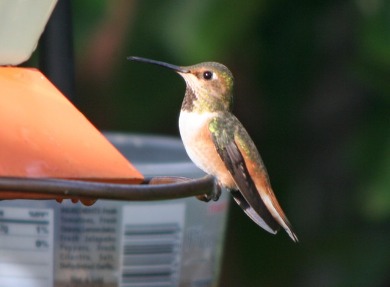
Appearance
Male Allen's Hummingbirds have a shiny green crown and back, while their wings are a mix of green, rufous (copper), black, and white.
Meanwhile, they have a rufous belly, rump, tail, and sides. Other defining characteristics are the white breast and the iridescent copper-orange throat.
Females look duller overall, plus their wings don't have any white. Their throats are also spotted and have a small patch of orange.
Both genders of this species look similar to Rufous Hummingbirds (we'll discuss that later!).
Habitat
Allen's Hummingbirds are usually only present in western Mexico and some southwestern states, such as Arizona, Oregon, and California.
However, they're an accidental species in Illinois. Sightings have only been during winter in the western borders of the state.
These hummingbirds are usually found in semi-open habitats, such as coastal forests, brushy canyons, well-wooded suburbs, and city parks. During winter, they mostly stay in mountainous habitats.
Fun Fact
The Allen's Hummingbird has various ways of eating, such as hovering while drinking nectar and taking grabbing insects straight out of spider webs.
2. Anna's Hummingbird (Calypte anna)
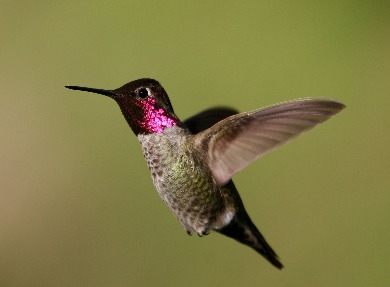
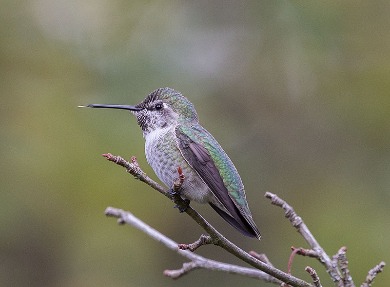
Appearance
Anna's Hummingbird has green upperparts, while its underparts are gray with some splashes of green.
Males have a conspicuous head and throat, as the iridescent reddish-pink color contrasts the rest of their body. Meanwhile, females only have a small red spot on their throats.
Habitat
Anna's Hummingbirds are found in the corners of western USA as a resident species. Meanwhile, they're seasonal species in southwestern Canada and northwestern Mexico.
This means that they're another accidental species in Illinois. They have only been sighted a few times during winter in Illinois, usually around Chicago.
These hummingbirds are adaptable, having various habitats that include deserts, mountains, coastal areas, and open woods. They also readily visit gardens, parks, and suburban areas.
Fun Fact
Compared to other hummingbird species in North America, Anna's Hummingbird consumes the most insects.
3. Black-Chinned Hummingbird (Archilochus alexandri)

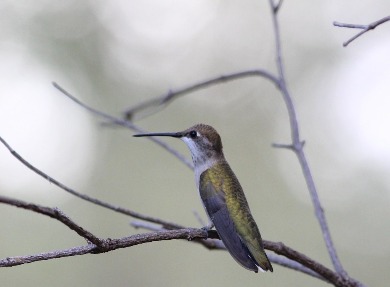
Appearance
To no one's surprise, the Black-Chinned Hummingbird has a black chin. Below this is an iridescent purple throat, although it isn't immediately visible due to the black chin.
Although females lack both of the features we just mentioned, both genders have green upperparts and gray underparts with a green wash on the sides.
This color pattern means that you may have difficulty distinguishing female Black-Chinned Hummingbirds from other species.
Habitat
Black-Chinned Hummingbirds are present in the western USA during summer, while in west Mexico during other seasons. However, they're rare visitors in Illinois outside their breeding season.
These hummingbirds are known habitat generalists, which means they're found in natural and urban areas, so long as there are trees, vines, and flowering plants.
They're often seen around backyard feeding stations or perched on a high tree branch.
Fun Fact
The Black-Chinned Hummingbird's nest is usually made of spider and insect silk, allowing it to expand as younglings grow in the nest.
4. Broad-Billed Hummingbird (Cynanthus latirostris)
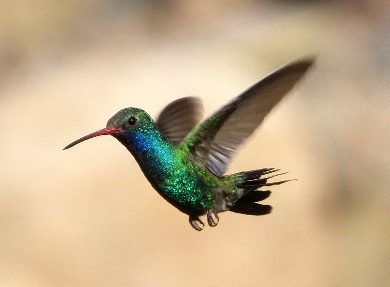
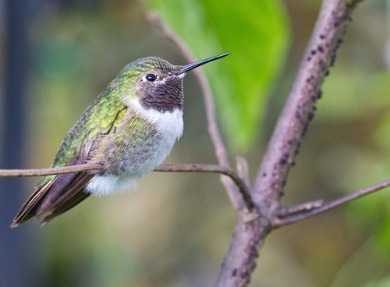
Appearance
Although the Broad-Billed Hummingbird has a broad bill indeed, it's not that easy to measure at first glance. Instead, look for red beaks with a black tip. This is a feature other hummingbirds in Illinois don't have!
Both species have metallic green upperparts, but only males have a bright blue throat, green belly, and white rump.
Meanwhile, females have white underparts and a black streak over their eyes.
Habitat
Broad-Billed Hummingbirds are permanent residents of central Mexico. When these hummingbirds migrate during winter, they fly north to southwestern states like southern Arizona and California.
However, some vagrants travel further north to Illinois and Wisconsin during breeding season. Sightings are more frequent in central Illinois.
They inhabit mountainous areas, usually around foothills, stream canyons, and other regions with streamside groves. During the cold, they may be found in desert countries.
Fun Fact
When Broad-Billed Hummingbirds cannot feed at night, they slow their metabolism and lower their body temperature to conserve energy.
5. Broad-Tailed Hummingbird (Selasphorus platycercus)
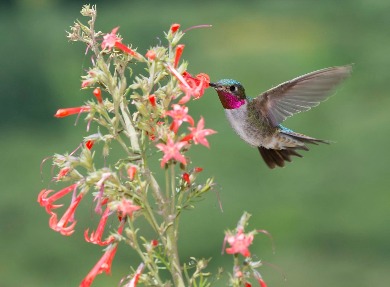
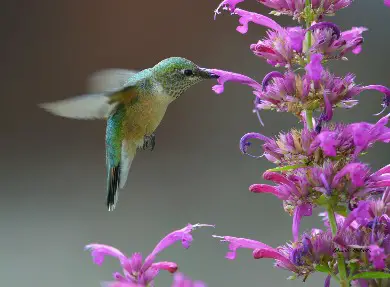
Appearance
From the name itself, the Broad-Tailed Hummibird has broad tail feathers visible during flight. Both genders have green upperparts, but the tail feathers may sometimes be rufous.
The males have an iridescent red throat and pale underparts with a green tint on the flanks. Meanwhile, the females have a pale throat and light brown belly.
Habitat
Broad-Tailed Hummingbirds are permanent residents of central Mexico. However, they can also be found in the western USA during summer and fall. Additionally, some may visit Illinois during hummingbird migration.
Their usual habitats are meadows and forests in mountainous areas. These forests are often open and near streams. During migration, they may make stopovers at lowlands.
Fun Fact
Philopatry is observed in Broad-Tailed Hummingbirds. This is a phenomenon where an organism stays or habitually returns to its previous home area.
6. Mexican Violetear (Colibri thalassinus)
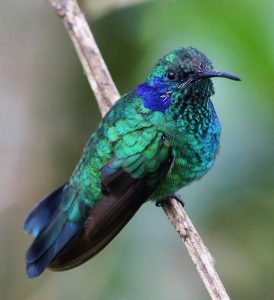
Appearance
The Mexican Violetear has a metallic green body with blue-violet patches on the cheeks, chin, and breast. Meanwhile, its tail is blue with a black band. Females have the same patterns as males, but they're duller.
Habitat
Mexican Violetears are usually residents of South and Central America. Still, some vagrants may wander to the USA during summer, especially in Texas.
They're usually found in forest edges and clearings and occasionally wandering around mountain ranges. They prefer areas with a high altitude and a lot of humidity.
It's been years since this bird has been spotted in Illinois, so there's little to no hope of seeing one in the state.
Fun Fact
The blue-violet patches of the Mexican Violetear give the appearance of a "violet ear," hence the name.
7. Ruby-Throated Hummingbird (Archilochus colubris)

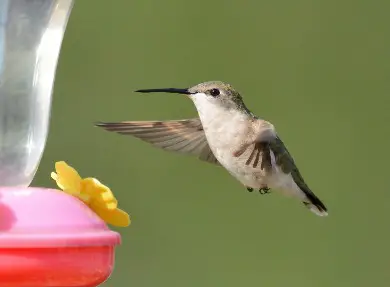
Appearance
As the name suggests, the Ruby-Throated Hummingbird has an iridescent ruby-colored throat. It has a black line on the chin that separates its red throat from the green upperparts. Meanwhile, its underparts are pale gray with a slight green tint on the sides.
On the other hand, females are duller than males. They also lack the black chin, and their throats are pale gray instead.
The Ruby-Throated Hummingbird looks a bit similar to the Broad-Tailed Hummingbird. The main difference is that the Broad-Tailed species lacks the black chin lining.
Habitat
Ruby-Throated Hummingbirds are common throughout the eastern half of the USA (including Illinois) and southeastern Canada during summer.
They travel to the central USA and Mexico during hummingbird migration, further down to southern Mexico during winter.
In Illinois, Ruby-Throated Hummingbirds are usually found in semi-open habitats, including woodlands, forest clearings and edges, parks, orchards, and gardens.
Fun Fact
The Ruby-Throated Hummingbird is the only species of hummingbird that breeds in eastern North America. It also has the most extensive breeding range out of all North American hummingbirds.
8. Rufous Hummingbird (Selasphorus rufus)
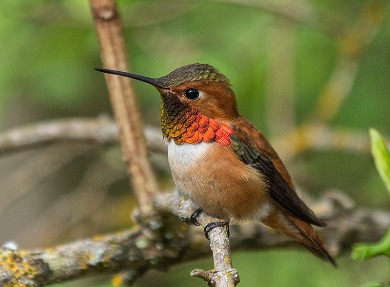
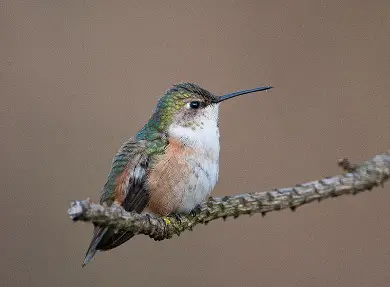
Appearance
The Rufous Hummingbird looks very similar to Allen's Hummingbird. In fact, the females and immature males of both species are pretty much indistinguishable.
Meanwhile, the easiest way to differentiate the males is by observing the back. The Rufous Hummingbird has a rufous back, whereas the Allen's is green. The Rufous also has broader outer tail feathers, although they're pretty hard to notice.
Habitat
Rufous Hummingbirds are widespread throughout southwestern Canada, the western half of the USA, and most of Mexico.
Some may wander to Illinois during winter, but they're infrequent. Most sightings occur in the northeastern parts of the state, especially around Chicago.
Rufous Hummingbirds inhabit forest edges, high-mountain meadows, and streamsides. They're also found around yards, parks, and other open areas.
When they migrate south to Mexico during winter, their habitat includes pine-oak forests and shrubby openings.
Fun Fact
The Rufous Hummingbird has an excellent memory for location, helping them find flowers. They've also been observed investigating the area of an absent feeder that was present the past year.
Watch This!
Frequently Asked Questions
How many types of hummingbirds are in Illinois?
To summarize, here are the hummingbirds in Illinois in alphabetical order:
- Allen's Hummingbird
- Anna's Hummingbird
- Black-Chinned Hummingbird
- Broad-Billed Hummingbird
- Broad-Tailed Hummingbird
- Mexican Violetear
- Ruby-Throated Hummingbird
- Rufous Hummingbird
The Rufous Hummingbird is the only consistent visitor to Illinois, whereas the other hummingbirds are only casual or rare visitors.
How do I attract hummingbirds in Illinois?
Nectar is the primary food source of hummingbirds. Therefore, one way of attracting hummingbirds is by adding native flowers to your backyard. These provide both nectar and insects for them to eat.
These birds usually favor tubular flowers. However, the color preference for these tubular flowers varies in every species of hummingbird.
You can attract more hummingbirds by placing nectar feeders that you fill with sugar water. You can make sugar water by mixing one part white refined sugar with four parts boiling water, then letting the mixture cool.
Please avoid adding more ingredients (like food coloring) to your homemade nectar.
When should I put out my hummingbird feeder in Illinois?
From the species of hummingbirds in this list, the best time to put out a hummingbird feeder is during winter and summer.
However, putting a feeder during other seasons is not a waste. Other birds in Illinois, such as House Finches and Downy Woodpeckers, also drink from hummingbird feeders.
It's crucial to remember that homemade nectar can spoil after 3-5 days. The spoiling process is further accelerated during summer, so make sure that you clean your feeder regularly.
Hummingbirds are also very aggressive, especially Rufous Hummingbirds. It's best to put your feeders as far apart as possible to avoid conflict.
Conclusion
Undoubtedly, hummingbirds are a sight you don't want to miss. Too bad none of them are permanent residents in Illinois.
That's why it's best to know what to look for! Once you successfully attract a rare hummingbird species to your backyard, you wouldn't want to miss the opportunity of documenting it.
With that being said, we hope this article provided you with the knowledge to identify the different Illinois hummingbirds. Happy birding!

